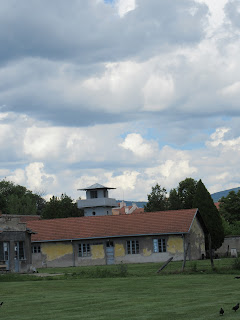When I was 16, I visited the concentration camp in Dachau, Germany. An experience that I can remember vividly, as if it were yesterday. And one that seared my heart and my soul. The memory so profound. And so painful. And at the same time so important in shaping my views on the need for tolerance and diversity and respect for the human dignity of every person.
We previously visited the Holocaust Museum in Skopje, where we learned that Macedonia lost the highest proportion of its Jews than any country in the world -- 98% were murdered during the Holocaust. This was the most complete annihilation of the Jewish community anywhere in the world. During the Bulgarian occupation of Macedonia during WWII, Jews were sent to their deaths in the Treblinka Concentration Camp in Poland.
(See blog post visit to Holocaust Museum in Skopje)
During our visit to Nis, Serbia I wanted to bring my daughter to visit the Crveni Krist Concentration Camp, so that she, too, would be able to bear witness to the horrors of the Holocaust. And that she, too, would learn and remember forever the painful and tragic lessons from such a museum.
From the Visit Nis tourist website:
http://www.visitnis.com/Concentration-Camp-from-the-WWTWO.html
"Nis Concentration Camp is one of few preserved German Nazi camps in Europe. Even today it provides an authentic testimony of the perils of the Serbian, Romani, and Jewish populations during the German occupation of Nis (1941-1944). In the authentic camp complex one can see authentically preserved towers, observation posts, guard boxes, central building with the cells and solitary confinements and personal items of the inmates such as documents,letters, weapons and photographs."
"A former Concentration camp in Nis, presents a witness of one of the darkest periods of the recent world history-the Second World War. In the occupied Serbia in September 1941, the authorities ordered that a Concentration camp be established in Nis (Anhaltelager Nisch) in the building of a deserted military warehouse near the train station ’’Crveni krst’’.
"At that place the Nazis imprisoned Jews, Roma, Serbs, patriots, as well as the members of the Chetnik movement, and many women and children. Enclosed with a double row of barbed wire, humiliated and tortured, prisoners were left to mercy of the camp commander and his assistants.
The living conditions in the main camp building were utterly inhuman – the rooms were dark, without heating in winter or ventilation in summer, and prisoners used to sleep on thin straw mattresses on a concrete floor. Food was, as one of the prisoners described it, “never full, always hungry”, in other words, barely enough to survive. In addition to the harsh conditions and the daily beastly torture, the prisoners were forced to hard labor either in the camp or outside.
"The fact that differs the camp from other Nazi camps is that on February 12, 1942. the inmates organized the first mass escape of prisoners in occupied Europe - a total of 105 managed to flee from the camp that day.
"It is estimated that during the occupation, there were more than 30.000 people in the concentration camp.
"Since 1967, the former Concentration camp has been a museum dedicated to all victims killed during the Second World War."









No comments:
Post a Comment